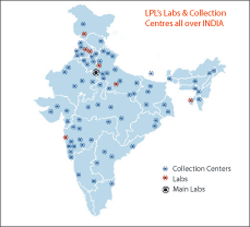Dr.Lal Path Labs was established in 1949 by Major S.K. Lal. One of India’s largest medical diagnostics company, it is primarily Delhi-based, though it has a pan-India presence. The total employee strength stands at 900. The technical core works hand-in-hand with the commercial wing in an ongoing attempt to scale-up operations.
The Growth Story
The company expanded rapidly to other parts of north India and across the country, such as Kolkata, Bombay and Bangalore. Starting with about 10 labs in 2005, today that number stands at 27 and plans are afoot to take this number to 50 by March 2009. Delhi itself presently has 7 satellite labs.


Located at Hanuman Road, Connaught Place, it is the first lab established by LPL in 1949. Equipped with highly sophisticated and state of the art instruments for testing in the field of Biochemistry & Immunoassays, High Performance Liquid Chromatography, Electrophoresis, Coagulation, Tandem Mass Spectrometry, Hematology, Histopathology, Cytopathology, Serology, Microbiology, Clinical Pathology and Immunology. It is open 24 X 7, enabling the company to service the market at any time. The laboratory acts as a central testing hub for Satellite labs, Pick-up points and Collection centres all over India.

The organisation has a pyramid structure with a central lab at Delhi, also called the reference lab. It does about 1650 tests, the widest menu by any lab in the country. In June 2007, Dr Lal Path Labs opened two high hi-tech laboratories in Kolkata. They have hi-tech laboratories in Mumbai, Ghaziabad, Faridabad, Bangalore, Jaipur, Chandigarh, Bhopal, Nagpur, Pune and Guwahati also.

Lower on the structure are the satellite labs. These perform 300-500 routine tests. Each satellite lab is flanked by sample collection centres. Presently there are 600 collection centres which is expected to touch 1000 by 2009-2010. Collection centres are franchisees though laboratories are owned by the company. A state-of-the art 4,000 sq ft facility was recently set up at its Gurgaon headquarters, exclusively for clinical trial operations.
This ensures that quality is maintained. Dr. Lal’s now operates what are called Patient Service Centres (PSC). These fall between a collection centre and a satellite lab. The difference between a lab and a PSC is that a patient will get all the services of a lab, except the testing. The experience is the same as would be when you walk into a lab. You can give the blood sample, you can have any query answered and collect your report.
Use Of IT
Quality is non-negotiable in this industry and Dr. Lal Path Labs ensure that all their labs are interconnected and the test reports are validated by a central pool of pathologists at the centre, before being delivered to the patient.
Each instrument is interfaced with a Unix-based Lab Information System – LIS. This LIS, called Ultra, is from Triple G (now with GE). Triple G is used by at least 100 top-notch labs in the world for LIS. Dr. Lal’s bought Triple G for 8 of their labs in 1999, making them the pioneers of LIS in India. Each instrument is bi-directionally interfaced with Ultra. The instrument speaks to the application and vice versa. This helps in monitoring quality in each of the labs. A process of validation is followed, where the values of various parameters are shaped to ensure that they are meeting the company’s SOP’s on quality.
There are two levels of quality control. The first is within the lab itself where the chief of a lab checks the reports. The other is that on a real time basis, the data also gets transmitted to the main lab in Delhi. The report sitting in Delhi is also monitored.
The second area where IT is used is between centres. The sample from the local lab might get split into two. Some tests will be done locally and others at the centre. The container has a bar code which the computer or other such instrument will recognise. The instrument speaks through the LIS and picks up the details of the tests to be conducted on that sample. Through this technology, it is also possible for the report to be delivered at a third location.
Speed is very important, along with accuracy of the report. The moment a sample is collected, the registration time and collection time is noted. Thereafter, every step is tracked until the report is finally uploaded onto the system. Patients can then download it from anywhere.
Be a part of Elets Collaborative Initiatives. Join Us for Upcoming Events and explore business opportunities. Like us on Facebook , connect with us on LinkedIn and follow us on Twitter, Instagram.











